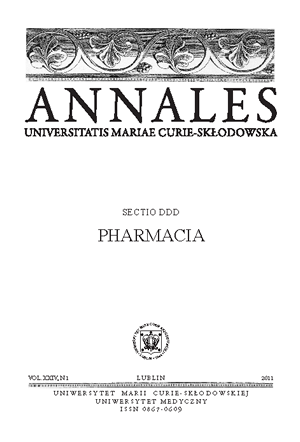The antinociceptive effects of topiramate evaluated in writhing test in mice
Keywords:
topiramate, antinociception, writhing test, miceAbstract
In the present study the antinociceptive activity of topiramate (TPM), new antiepileptic drug with multiple mechanism of action, in writhing test in mice was evaluated. It has been shown that TPM, given at the doses of 25, 50 and 100 mg/kg, was able to induce antinociception.
The diminution of TPM’s antinociception by naloxone and the lack of interactions between TPM and morphine, suggest that δ-opioid receptors are engaged in observed antinociceptive effects of TPM. Moreover, the antinociceptive effects of threshold dose of TPM were significantly enhanced by ethanol which could be a result of their common influence on GABA and/or hyperexcitable aminoacids systems and may also point to participation of δ-opioid receptors. The interactions between TPM and ketamine or diazepam have not been shown. Therefore, the role of GABA and hyperexcitable aminoacids systems in mechanism of action of TPM seems to be debatable.
In conclusion, our studies confirm the effectiveness of TPM in writhing test in mice and seem to suggest that opioid system, at least partially, participates in analgesic mechanism of action of the drug. However, further investigations in this area are needed.
References
1. Calabresi P. et al.: Antiepileptic drugs in migraine: from clinical aspects to cellular mechanisms. Trends Pharmacol. Sci., 28, 188, 2007.
2. Carmona S., Bruera O.: Prophylactic treatment of migraine and migraine clinical variants with topiramate: an update. Ther. Clin. Risk Manag., 5, 661, 2009.
3. Dahlöf C. et al.: The impact of migraine prevention on daily activities: a longitudinal and responder analysis from three topiramate placebo-controlled clinical trials. Health Qual Life Outcomes, 5, 56, 2007.
4. Donofrio P.D. et al.: Safety and effectiveness of topiramate for the managament of painful diabetic peripheral neuropathy in an open-label extension study. Clin. Ther., 27, 1420, 2005.
5. Edvinsson L., Linde M.: New drugs in migraine treatment and prophylaxis: telcagepant and topiramate. New Drugs Class, The Lancet, 376, 645, 2010.
6. Edwards K.R. et al.: Efficacy and safety of topiramate in the treatment of painful diabetic neuropathy: A double-blind, placebo-controlled study. Neurology, 54 (Suppl 3): A81, Abstract, 2000.
7. Ferrante F.M.: The pharmacologic managament of neuropathic pain. Semin Anesth, Perioperative Medicine and Pain, 22, 168, 2003.
8. Ferraro D., Di Trapani G.: Topiramate in the prevention of pediatric migraine: literature review. J. Headache Pain, 9, 147, 2008.
9. Fidecka S. et al.: The development of cross tolerance between ethanol and morphine. Pol. J. Pharmacol. Pharm., 38, 277, 1986.
10. Fleming M., Mihic S.J., Harris R.A.: Ethanol. In: Goodman and Gilman’s: The Pharmacological Basis of Therapeutics, 11th edn. Eds. Brunton LL, Lazo JS, Parker KL, McGraw-Hill, USA, 591, 2006.
11. Gilron I. et al.: Topiramate in trigeminal neuralgia: a randomized, placebo-controlled multiple crossover pilot study. Clin Neuropharmacol, 24, 109, 2001.
12. Golden A.S., Sheryl R.H., Solomon L.M.: Nonepileptic uses of antiepileptic drugs in children and adolescents. Pediatr Neurol, 34, 421, 2006.
13. Guay D.R.: Adjunctive agents in the management of chronic pain. Pharmacotherapy, 21, 1070, 2001.
14. Gutstein H.B., Akil H.: Opioid analgesics. In: Goodman and Gilman’s: The Pharmacological Basis of Therapeutics, 11th edn. Eds. Brunton LL, Lazo JS, Parker KL, McGraw-Hill, USA, 547, 2006.
15. Koster R., Anderson M., De Beer E.J.: Acetic acid for analgesic screening. Fed. Proc., 18, 412, 1959.
16. Langtry H.D., Gillis J.C., Davis R.: Topiramate. A review of its pharmacodynamic and pharmacokinetic properties and clinical efficacy in the managament of epilepsy. Drugs, 54, 752, 1997.
17. Le Bars D., Gozariu M., Cadden S.W.: Animal models of nociception. Pharmacol. Rev., 53, 597, 2001.
18. Lopes L.S.: Antinociceptive effect of topiramate in models of acute pain and diabetic neuropathy in rodents. Life Sci., 84, 105, 2009.
19. Matosiuk D.: Synthesis and pharmacological activity of new carbonyl derivatives of 1-aryl-2-iminoimidazolidine. Part 2. Synthesis and pharmacological activity of 1,6-diaryl-5,7(1H)dioxo-2,3-dihydrimidazo[1,2-a][1,3,5]triazines. Eur. J. Med. Chem., 37, 761, 2002.
20. Pappagallo M.: Newer antiepileptic drugs: possible uses in the treatment of neuropathic pain and migraine. Clin. Ther., 25, 2506, 2003.
21. Rosenfeld W.E.: Topiramate: a review of preclinical, pharmacokinetic, and clinical data. Clin Ther, 19, 1294, 1997.
22. Ruiz L.: Topiramate in migraine progression. J Headache Pain, 2009, 10, 419, 2009.
23. Shannon H.E., Eberle E.L., Peters S.C.: Comparison of the effects of anticonvulsant drugs with diverse mechanisms of action in the formalin test in rats. Neuropharmacology, 48, 1012, 2005.
24. Silberstein S.D.: Topiramate monotherapy in epilepsy and migraine prevention. Clin Ther, 27, 154, 2005.
25. Stepanović-Petrović R.M.: The antinociceptive effects of anticonvulsants in a mouse visceral pain model. Anesth. Analg., 106, 1897, 2008.
26. Talarek S., Fidecka S.: Role of nitric oxide in benzodiazepi es-induced antinociception in mice. Pol. J. Pharmacol. 54, 27, 2002.
27. Tabakoff B., Hoffman P.: Biochemical pharmacology of alcohol. In: Psychopharmacology. Ed. Meltzer H.Y., The Third Generation of Progress. Raven Press, New York, 1521, 1987.
28. Thienel U.: Topiramate in painful diabetic polyneuropathy: findings from three double-blind placebo-controlled trials. Acta. Neurol. Scand., 110, 221, 2004.
29. Vogel G.H., Vogel W.H.: Drug Discovery and Evaluation, Pharmacological Assays Springer-Verlag, Berlin, 382, 1997.
30. Wieczorkiewicz-Płaza A.: Effect of topiramate on mechanical allodynia in neuropathic pain model in rats. Pol. J. Pharmacol., 56, 275, 2004.
Downloads
Published
Issue
Section
License
Copyright (c) 2011 Authors

This work is licensed under a Creative Commons Attribution-NonCommercial-NoDerivatives 3.0 Unported License.


